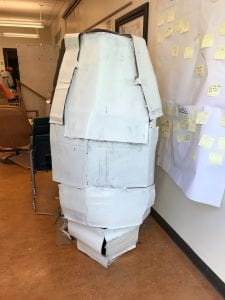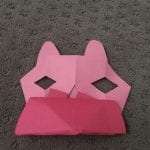A few weeks ago, I presented my second DI Challenge Solution! This is our second time doing Destination Imagination, and I worked with Jordyn, Fraser, Kyle, and Jackson to create a play based on the game Hungry Hungry Hippos.
You can see how my group last year worked through our Challenge here and here.
Destination Imagination is a worldwide tournament designed to bring out the creativity in kids from preschool to university. It has a variety of challenges for students to solve, in several categories, like Fine Arts, Engineering, Scientific, and Improvisation. This year, my group chose the Fine Arts Challenge, ‘Game On’!
This challenge required a few things: a Container that held all of our props and costumes, fit through a doorway, and transform during the presentation, a Game Gizmo that impacted our presentation, Research of the Game we chose incorporated into the story, a good Story based on the game that included two different perspectives, a Technical Element created using Technical Methods, and two Team Choice Elements that we picked, showcasing our strengths. Creating a challenge solution was pretty difficult, and to showcase how we did it, I’ll take this post through the five steps we, and tons of other DI Challenge Participants, followed to create the solution.
The first step is Recognize. This step is when the group ‘recognizes’ the requirements of the Challenge. The requirements for the challenge, as listed above, are complicated and it takes a while to understand them, which is what this stage is about. We reviewed the different elements of the challenge until we knew we understood it.

The Hungry Hungry Hippos Game. Image Credit Here
The next stage is Imagine. We did some idea-generation exercises to decide the Game we would focus on, and worked together to figure out what general goals we wanted to set for our final solution. The Game we decided on was Hungry Hungry Hippos, and we really wanted a story about the Hippos dealing with a new situation that doesn’t occur in the game. Then, we decided that it would be revealed to be a TV ad that some bored kids are watching. This became a really important part of our story, incorporating the two different perspectives aspect of the Story.
The third stage, and a very important one, is Initiate and Collaborate. This is when we made the important decisions of the challenge. We encountered numerous struggles during this stage, like figuring out how the Container would transform and how the Game Gizmo would impact the presentation. Our script, which I wrote most of, features the Hungry Hungry Hippos, (Happy, Harry, Henry, and Homer) encountering a mysterious egg, which hatches, revealing a jellyfish who teaches them about the power of sharing. The egg is our container, and it took some time to figure out how it would hatch. It was also our technical element, which meant we had to use technical methods for it! Finally, we decided that the egg would have a door on hinges, which would swing open automatically. To keep it from swinging open immediately, it was ‘locked’ with a string secured between two magnets. To unlock it, you simply move a lever on the side, pushing the magnets apart. To build the egg, Jordyn and I got work with cool power tools like power saws, drills, and jigsaws to create the frame of it, made out of cut wood screwed together at 20 degree angles.
- The first drafts of the mask.
- The second draft of the mask. It had a nose, but there was something a little off.
- The third draft of the mask. Better, but too small.
Our Game Gizmo is the mask that Jackson, one of our team members, wears to pull the lever away. The mask is adjustable, and created from origami. The origami is one of our Team Choice Elements. The other Team Choice Element in our presentation is the lights sewed to the jellyfish’s shirt. We worked really hard on the origami, and had to make several drafts to make the masks work. The lights were difficult because the batteries we used burned out unexpectedly, so it was difficult to tell whether the circuit wasn’t closed or the batteries were burned out. Jordyn came up with a really good way to turn the lights from off to on quickly, without having to press a bunch of small buttons. She wrapped the ends of the conductive thread in the circuit in pieces of tinfoil, which would turn the lights off when they touched each other, closing the circuit before it reached the lights.
When we presented, we were pretty stressed, but we’d spent some time on the day of the tournament going over our lines. I really enjoy playing my character, Harry, the conspiracy theorist. After all, even though it’s stressful to be watched and appraised, I still had a good time acting the part.
The fourth stage is Assess, which is this blog post! This is when we look back on what we did, and figure out what we can do better- just in time for Provincials! I think that our solution worked pretty well, and we won in our category! That doesn’t mean that there isn’t still room to improve, though. I think that the Hippo masks could be improved a little, and we could maybe incorporate more research of the game into our story.
All in all, I think that this DI Challenge has been a really positive experience, and I think it’ll just get better at Provincials.
Thanks for reading my blog post!





